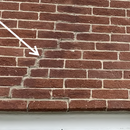Replacing Lintels in Brick House
I’m doing my homework before replacing 25 windows in our new-to-us 1806 brick house. There are some spots where there’s cracking/bowing above windows, and I was thinking it’s lintel failure that I should get addressed while the windows are out. But, I just had a realization. The house was built before the invention of the steel lintel. Where I had assumed that there was a steel lintel… there might be nothing. Is there some hidden lintel detail that would have been used in the 1800s, or am I looking at a structural wooden window frame?
I’ve attached a picture of a failing location.
GBA Detail Library
A collection of one thousand construction details organized by climate and house part










Replies
The histories of lintels that I'm reading have some contradictions, and some don't mention that angle iron / cast iron lintels pre-dated steel lintels. I am admittedly still concerned that I'm looking at structural wood.
I used to volunteer at a historic iron village in NJ that produced cast iron lintels in the 1830's. At that time, they were already a somewhat common item. I don't have any direct experience with any iron lintels in earlier buildings, but with a booming iron industry dating back into the 1700's, I would suspect that they existed.
In your case, you simply have to open up the walls around one of the windows to find out. The brick you show is certainly showing signs of lintel failure. It is designed to be supported by a structural lintel, as there is no structural arch supporting the opening. Wood lintels would not be all that unusual for residential construction at the time. Repairs will be tricky, as are most repairs in very old buildings. If there are original structural wood lintels, they were probably made from white oak or chestnut, both of which are quite stiff and strong, and both have significant rot resistance, even if they are not classified as "rot-resistant" by current standards. You can't get chestnut anymore, but white oak is still available and would be appropriate for in-kind repairs. Of course you could also have new steel lintels fabricated and installed so that they don't show. Any of this sort of repair will obviously be much more involved than simply replacing windows.
Depending on what we find in the walls, I'm considering helical bar repairs, which look relatively non-invasive. You cut horizontal slots in the mortar above the opening, and mortar in horizontal stainless steel bars. The bars stitch together the bricks across the width of the opening and bear the tension.
https://thorhelicalusa.com/wp-content/uploads/2017/11/33501-Thor-Helical-Lintel-Repair-A4-FINAL-3.pdf
Tension rods like that can work. You have to be very careful about the installation. You will need the grout gun and special grout specified by the manufacturer of the bars. The bars must be fully bedded in grout and the joints must be clean so that the grout bonds to the masonry. You would like to finish the structural grout about 1/2" below the brick surface so that you can finish pointing the brick with mortar that matches the color and texture of the original. There's also some art to using a diamond blade on the angle grinder to remove the existing mortar without cutting into the brick. Very dusty and noisy work. A HEPA vacuum hood on the grinder is a good idea.
It looks like your mortar joints are pretty thin. That's common with old brick. They might be too thin for the proper sized rods and grout joints. That would make this solution less likely.
If you are close to a big, old city, you might be able to find a contractor to do this work. Search for "restoration masons" or "masonry restoration." They usually do big commercial buildings and may not be very interested in residential work, but it's worth a try. Don't hire a mason that doesn't already specialize in restoring old masonry. They won't have the proper skills and will likely destroy your brick.
We are, in fact, next to some big old cities, and I've reached out to five or six firms that claim to do restoration of historical masonry, with varying levels of specialization. We'll see what they say when I talk to them.
I note that Thor Helical sells a crack stitching kit with grout, gun, rods and hand tools. They also sell 7 meter lengths of the 6mm rods. BYO grinder and drill though. It's kind of attractive, but also I see your points about getting it right.
Older brick houses around me almost universally have brick arches. If there is a lintel you should be able to see the edge of it as it typically starts about 1.5" from the edge of the brick.
Except for the rare early 1900s lintel, about the only time I've seen something like that is a hack job when the window was cut later and they did not install a lintel.
Unfortunately the proper fix is not simple. A good brick mason should be able to fix that for you in about a day or two. Be careful as removing the window might cause the brick to fall, I wouldn't do anything till somebody checks it out.